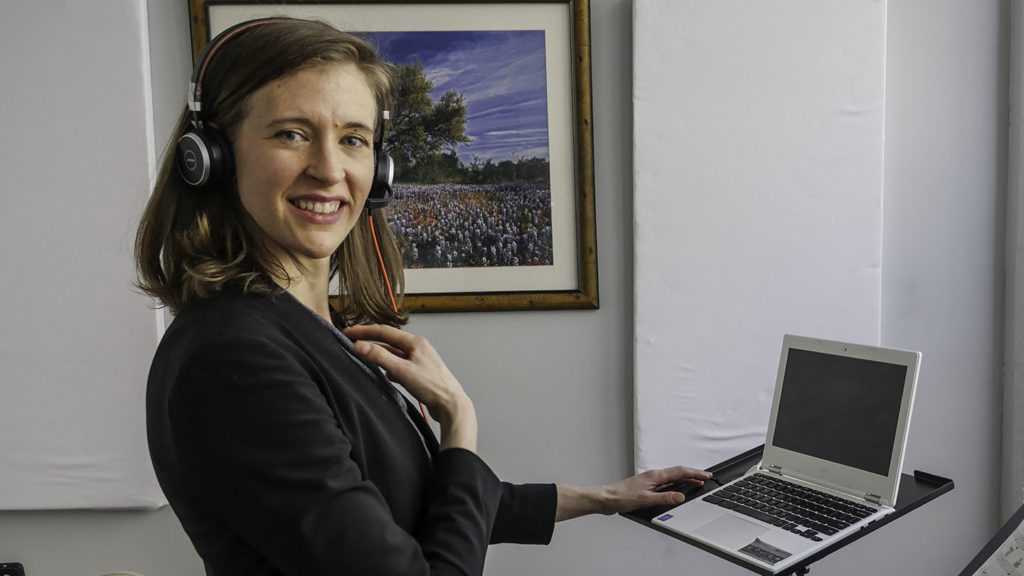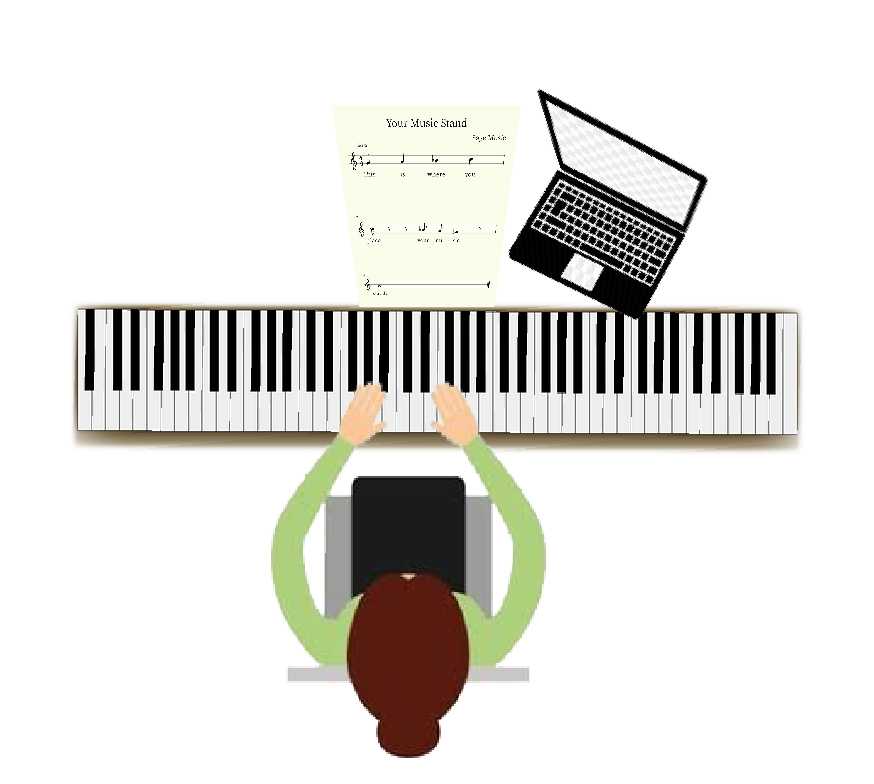How to get the most out of your online voice lessons

Taking online voice lessons is a great opportunity to develop a new skill, or brush up on your singing.
An added benefit is that you can choose the best teacher for you from over the entire world. But make sure to work with someone who is a professional music teacher.
Just because someone is a good singer does not make them a good teacher.
With the right teacher, you can prepare for performances, auditions and recordings, perform at open mics, or even sing your first song!
Equipment for your online singing lessons
Equipment you’ll need:
- A video and audio enabled device with an internet connection
- Smartphones, laptops and tablets all work fine
- Devices with larger screens are preferable
- A way of stabilizing your device, like a small tripod stand
- A music stand
- Note taking materials
Optional equipment:
- A headset with a microphone, or a USB microphone with a pop filter
- A piano, keyboard, or guitar
- Water (recommended!)
Headsets and microphones
Some headsets and microphones can be wonderful for capturing the sound of your voice.
However, most of them are designed for regular talking. The singing voice is often too loud for these microphones and causes them to sound distorted.
If your headset causes distortion, it is better to use the microphone and speakers that are included with your device. If you still have distortiong, you can stand further away. That will often get rid of any distortion.
However, for the best audio during your singing lesson, consider a USB microphone with pop filter.
A quality microphone will ensure that your voice comes through clearly. And a USB microphone will connect directly to your laptop or computer. Easy!
If you use a microphone that has an XLR connector, you will also need an audio interface, cables, and more. It is probably not worth the hassle.
A pop filter will reduce any popping sounds that are generated by your breath hitting the microphone directly while you are singing. This way, your voice teacher can better hear the intricacies of your voice during your singing lesson.
Some great USB microphone options for your voice lesson:
- Røde NT
- Blue Snowball (This one comes with a handy table/desk mount!)
When you need a musical instrument
If your goals include learning to read music, or learning to sing and play an instrument at the same time, you’ll want to have a piano, keyboard or guitar easily available.
That way, you can always be building the habit of singing while playing your instrument of choice.
Your singing teacher can also help you coordinate your singing with your instrument.
Your online voice lesson setup
Camera Setup: Proper placement helps your teacher see your vocal technique
Place your camera:
- Directly in front of you
- at eye level
- about arm’s length away
The best position is directly in front of you at eye level. This helps your instructor clearly see what you are doing with your face, neck, jaw, and shoulders. It also allows you to see your voice teacher‘s demonstrations without having to turn and look.
Using your tripod, position your camera so that your teacher can see your head and upper torso. This is about arm’s distance in front of you.
Also, remember that if the microphone is too close, you could get distortion. Placing your device slightly further is probably better than placing it slightly closer during your voice lesson. This will allow your teacher to see more of your posture, too.
Pro tip: If you are learning to play an instrument while singing, use two camera-enabled devices for your lesson.
The ideal camera placement would be:
- A larger device (i.e. a tablet or laptop) that displays your face and the top half of your body
- A smaller device (i.e. a phone) to record your hands on the piano or guitar
Should you sit or stand for your voice lesson?
It depends on your goals!
For example, if you want to sing in a rock band, you’ll definitely stand for your lesson. That’s because you’ll be standing up when you perform.
But sometimes in musical theatre, you sing roles or songs while seated, or even reclining. So in this case you may practice some parts in a position other than standing.
You can learn to sing well in either position. Your instructor will guide you through proper posture seated or standing so that you can support your voice and sing with freedom.
See how much of the role is sung seated in this video:
Where to place your music

Remember to always have your music printed out and in a 3-ring binder (or other method that lies flat) or on a PDF Reader so that you can find it easily and communicate with your teacher.
You’ll then put your music just to the side of your camera using your music stand. Either side is ok.
Preparing for your online singing lessons
Your Internet Connection
Other than a camera with microphones and speakers, your most important tech need is a solid internet connection.
Your connection speed is more important for your video lesson than your microphone or headset.
It won’t matter how good your camera and microphone are if the signal can’t make it to your teacher! Unstable or slow internet connections cause bad video and audio quality.
Worse, bad connections can cause your audio and video to be choppy, leaving you confused or missing important demonstrations during your lesson.
Wired connections work better than wireless. They are faster and more stable. Plug in when you can.
While most recommend a 5Mbs connection – and 5Mbps will do – we recommend a 10Mbs connection or faster for the best online video lessons. Since the video will travel both ways, you’ll need 10Mbps upload and download speeds.
Many internet companies give you a fast download speed, but a slower upload speed, so be sure to test. Test your speed here.
Read this article on Medium if you want more details about required speeds.
Set up in advance to avoid delays starting your voice lesson
It’s always best to set up before your singing lesson so that you don’t waste any of your lesson time on these details.
- Choose and set up your practice space
- Test your camera and microphone
- Prepare your music
- Charge/plug in your device
- Grab some water
Practice Space
Do your best to ensure that your lesson space is clean and distraction-free, to get the most out of your singing lesson. Any distractions will affect the quality of your lesson.
Make sure that all of the materials or equipment will need are within reach. That includes your camera, electronic device, instrument(s), note taking materials, music, and water.
Test your camera and audio
Test your camera in advance of your singing lesson to ensure that your camera positioning is right.
It’s also smart to test your microphone in advance as well, so that you can be confident that your voice teacher will be able to hear you right away. You don’t want to waste time making unneccesary adjustments after your singing lesson has begun.
Your Music
Have any sheet music or accompaniment files ready to go so you don’t have to search for it during the lesson. Also share any new sheet music, lyrics, or video links with your teacher so you don’t have to do so during the lesson.
Plug in your devices
Make sure that your devices are plugged in and/or charged. Plugged in is better if possible, as video calls drain the battery very quickly.
Keep water handy
everything in your vocal cords is working properly. Practicing while dehydrated can cause your vocal folds to become dry
and even permanently injured. Make sure to have a bottle of water near you!
Now you’re ready to have your online singing lesson!
During your online voice lesson
Now that you have done all the prep work it’s time to let your teacher run the show. Relax, and get to work on improving your singing voice!
Communicate with your voice teacher
Your online singing lessons will require clear communication between you and your voice teacher. That way, your time with your voice teacher will be the most productive.
- Make note of your questions during weekly practice
- Be open to further camera and audio adjustments
- Communicate your needs directly with your teacher
Make sure you have made note of any questions that you have for your teacher during your practice between your singing lessons. Your teacher is here to help clarify anything you are unsure of.
Also be open and communicate with your teacher about camera angles and set up. They may ask you to make further changes so that they can see you while you are singing. That way, they offer the best instruction to keep you building the right habits for your singing.
You should also feel free to ask your voice teacher to make any adjustments to their camera angles or audio set up that will help you see and hear their demonstrations in the best way.
Always remember to take charge of your own learning. If you need something, always ask for it. As they say, you don’t get what you don’t ask for.
Related

Sage


Staff
